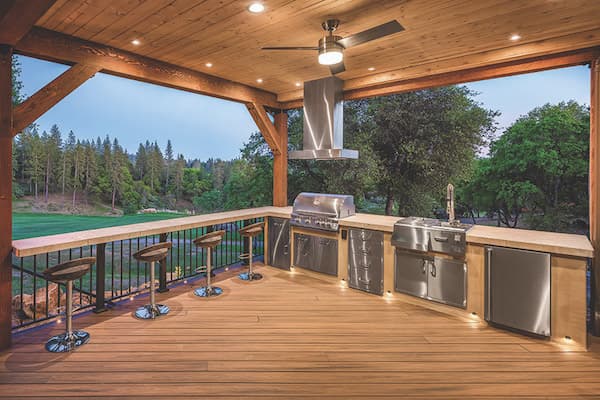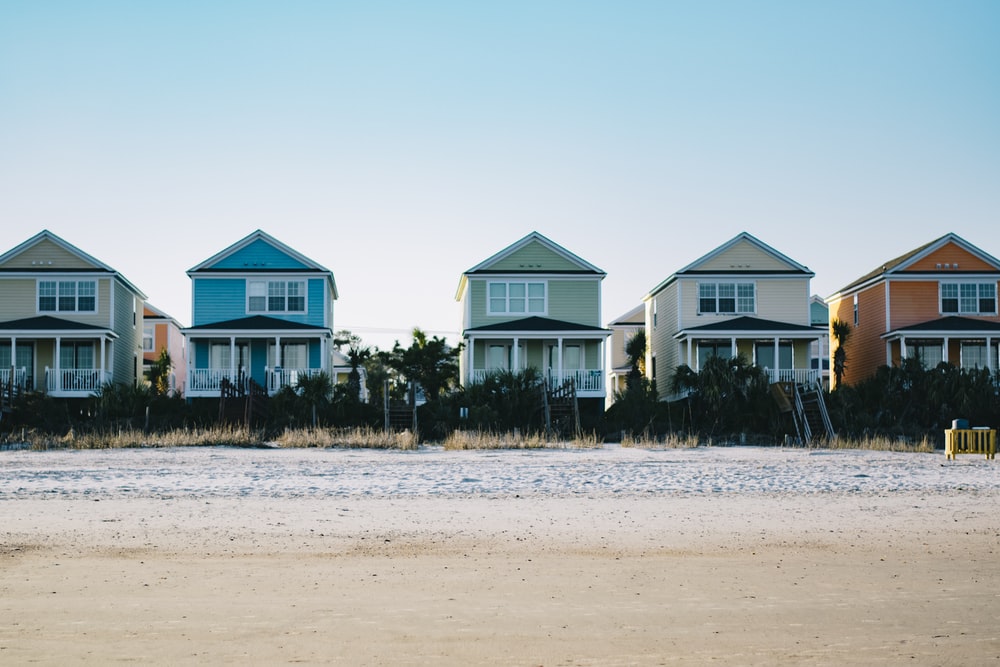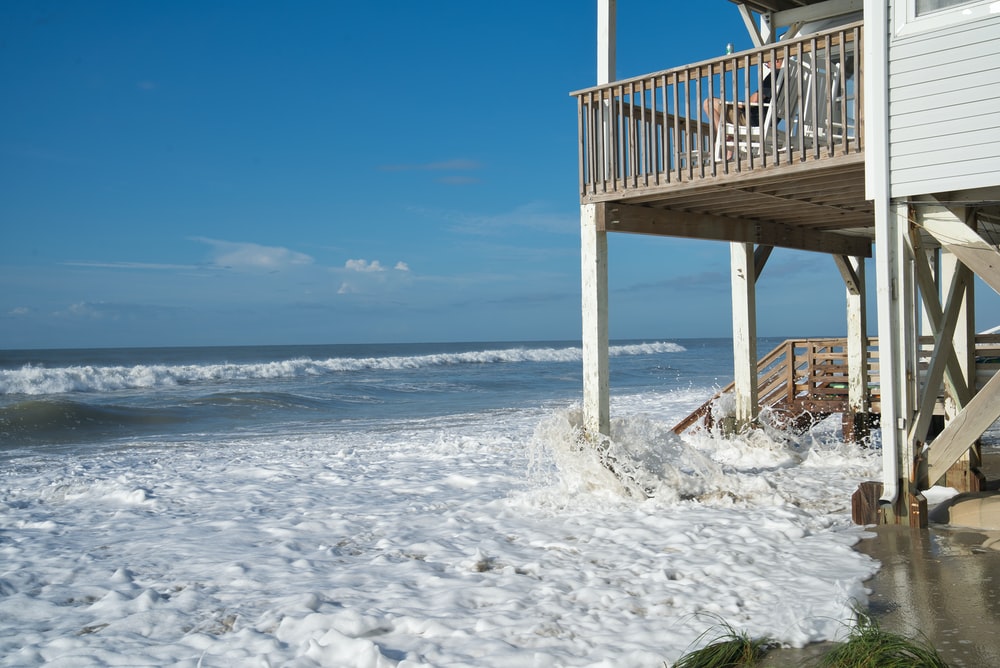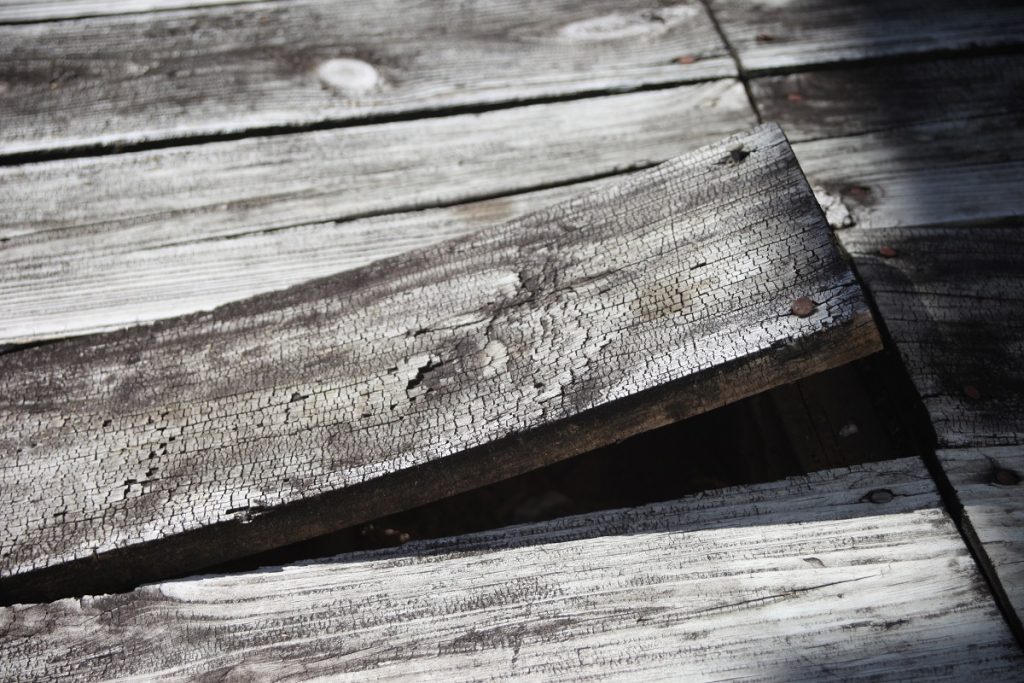What to Put Under Deck for Moisture Resistance

Imagine relaxing on your deck, enjoying a serene evening as the sun sets. While the surface of your deck is essential, what lies beneath is equally crucial. Protecting against moisture, weeds, and other unwanted problems ensures your deck’s longevity and safeguards your home’s foundation. Let’s explore what to put under deck for moisture resistance and how different materials can make a difference.
What to Put Under Deck for Moisture Resistance
Moisture barrier options for deck floors include wet/liquid membranes and rolled/sheet membranes, both of which can aid in waterproofing beneath the deck. Most builders favor the more effective rolled waterproofing since it can provide a more uniform moisture barrier surface compared to the less expensive wet membranes.
Mulch, Sand, Soil, Gravel? How To Choose What You Put Under Your New Deck
When planning a new deck, there are numerous decisions to make, from selecting between wood and composite decking to choosing deck board colors and the overall design. However, an often-overlooked but important question is what to place underneath your deck.
There are several options for under-deck materials, such as gravel, mulch, sand, and soil. But which one is the best choice for you? In this blog, we’ll explore the pros and cons of each material to help you make an informed decision for your deck project.
Read more: How to Build a Four Season Room on a Deck
What Are the Pros and Cons of Different Under Deck Materials?
- Gravel Under Decking
The Pros of Gravel Under Decking
Excellent for Drainage: Gravel is a top choice for ensuring high drainage levels. Since gravel doesn’t absorb moisture, water beneath the deck flows away instead of soaking into the material, reducing the risk of dampness. Less moisture also means fewer mosquitoes around your deck.
Weed Prevention Benefits: Gravel is highly effective in preventing weeds. Plants, including weeds, thrive in moist environments. With gravel, the lack of moisture inhibits weed growth under the deck, preventing them from damaging the decking. This also helps deter rodents and other small animals from taking up residence beneath your deck.
Doubles as Storage Space: If you’re looking to utilize the space under your deck, gravel is an excellent option. Especially with a high deck, the area underneath can serve as a useful storage space. Gravel’s inability to hold moisture provides a relatively dry storage solution. For even better protection, consider using Dexerdry, a patented above-floor joist flange gutter system that creates a virtually dry space under your deck by preventing water penetration.
Non-Flammable: Gravel is also non-combustible, making it a safe choice for areas near homes or other buildings. Using non-flammable materials is crucial for safety, and gravel meets this requirement effectively.
Visually Appealing: Gravel under a deck offers an aesthetically pleasing, clean look. With various types of gravel available, you can choose the perfect style to complement your deck’s appearance.
The Cons of Gravel Under Decking
It Can Be Costly: Gravel tends to be one of the pricier choices for deck underlayment. While you can find budget-friendly options such as plain crushed rock, these still often cost more than alternatives like mulch.
Also, if you’re aiming for a particular aesthetic, you might opt for premium gravel types, which can be even more expensive.
Mulch Under Decking
The Pros of Mulch Under Decking
Inexpensive Option: Mulch is usually a budget-friendly material for use under your deck. If cost is your primary concern, mulch is likely your best choice.
Low Flammability: Contrary to popular belief, wood mulch is not highly flammable. For the least flammable wood mulch, select coarse materials. Fine wood chips and rubber mulch are among the most flammable options available.
The Cons of Mulch Under Decking
Retains Moisture: Mulch tends to hold a significant amount of moisture, which can result in mold, mildew, or fungi developing under your deck. This damp environment may also attract insects, rodents, and other small animals. Excessive moisture can cause wooden decking or non-capped decking to rot.
Placing a fabric layer beneath the mulch can mitigate this issue somewhat, though not entirely. Using rubber mulch instead of wood mulch can also help reduce moisture retention and the associated problems.
Weeds May Grow Through the Mulch Layer: The moisture-retaining properties of mulch can encourage the growth of plants, like weeds. While weeds might not directly harm your deck, they can cause staining due to their organic matter. To maintain the visual appeal of your deck, it’s important to manage weed growth. Adding a fabric layer and/or using rubber mulch can effectively deter weeds and minimize the risk of staining on your deck surface.
Needs to Be Replaced Regularly: Although mulch is inexpensive, it decomposes quickly and will need to be replaced regularly. This increases the lifetime cost of your chosen under-deck material and the replacement process is time-consuming.
Rubber mulch, in contrast, decomposes much slower than wood mulch, reducing the frequency of replacements needed.
Sand or Soil Under Decking
Sand and soil offer predominantly the same benefits and similar issues.
The Pros of Sand or Soil Under Decking
Affordable: Like mulch, sand and soil are cost-effective materials to use under a deck. They are readily available, so finding a supplier for sand or soil should be easy if you choose these options.
Non-Flammable: If you’re worried about your under-deck material being flammable, sand is a safe choice. It’s non-combustible and won’t burn, eliminating any fire hazard. Similarly, soil is also not very flammable due to its high moisture content.
Suitable for Flat Decking: Sand and soil work well for flat decks, such as decking paths, rather than raised deck areas. They can be placed beneath the decking boards, providing a protective layer between the ground and the deck boards.
The Cons of Sand or Soil Under Decking
Lack of Visual Appeal: If the area beneath your deck is visible, using sand or soil may not be as visually pleasing as other materials like gravel. Typically, sand or soil is chosen only when the space under the deck is not visible.
Attraction to Insects and Animals: Sand and soil can attract insects, rodents, and small animals. While these pests are more commonly drawn to wooden decks, our composite and PVC decking materials are designed to resist insect damage. With our residential decking options, you get a durable, pest-resistant solution that reduces the risk of damage, ensuring long-lasting performance and peace of mind.
Moreover, certain creatures like mice can pose health risks and may attract predatory animals such as snakes if they nest or burrow in the soil or sand.
Water Retention: Although sand and soil can dry out quickly, they retain moisture if exposed to continuous wetness, such as during heavy rainfall. This moisture can promote mold, mildew, and weed growth on your decking.
Erosion Concerns: Sand can erode rapidly when exposed to the elements, requiring frequent replacement or topping up, which can be time-consuming and costly. Soil also erodes, although typically not as quickly as sand.
Plant Growth: Sand and soil encourage plant growth, similar to mulch. Placing a fabric layer beneath these materials can reduce the chances of weeds and other plants growing through and near your decking.
What is the Best Material to Put Under a Deck?
Gravel is typically the top choice for the area beneath a raised deck due to its numerous advantages. While it may cost a bit more than alternatives, it offers superior benefits. It’s non-flammable, doesn’t retain water, and is less likely to attract plants, insects, or small animals. Gravel also comes in various colors and textures, enhancing its aesthetic appeal.
If budget is a concern, coarse wood mulch can be a decent alternative, although it has more drawbacks compared to gravel. Rubber mulch, while less prone to water retention issues, carries a higher risk of flammability than wood mulch.
Sand and soil are viable options if the deck is used for pathways or flat surfaces, but they’re generally not recommended for use under raised decks due to various limitations.
- Put a Drainage System Under the Deck
When uncertain about what to place under a deck to handle heavy moisture, opting for a drainage system proves beneficial. Installing such a system post-deck construction can be challenging due to limited space. It’s advisable to integrate the drainage system during deck preparation, if feasible.
To prep the ground beneath the deck for the drainage system, installing troughs to channel water away to another part of the property is necessary. A French drain might be needed to divert water from under the deck to a location farther from the home’s foundation.
One perk of using a drainage system is the additional space it creates for storing kids’ toys or lawn equipment. With the drainage system in place, concerns about these items being in water puddles are alleviated.
- Put Landscape Fabric Under the Deck
Landscape fabric serves as a lightweight yet effective moisture barrier beneath a deck, particularly in areas where standing water isn’t common. It stabilizes soil, preventing weed growth and maintaining the area’s aesthetic appeal.
For optimal performance, cover the landscape fabric with a layer of gravel or rocks. Without this covering, dirt may accumulate on the fabric’s surface, potentially leading to weed growth. Additionally, rocks improve the visual aspect compared to using fabric alone.
During installation, consider using treated wood landscape timbers as a perimeter barrier. This allows you to attach the fabric securely to the wood, preventing displacement. The wood barrier also helps keep the gravel in place, minimizing debris on your lawn.
For the fabric itself, opt for woven stabilization fabric. This type promotes gradual water seepage into the soil below, ensuring proper drainage. In contrast, plastic landscaping material can hinder water seepage, leading to water accumulation under the deck or runoff into the yard.
- Put Concrete Under the Deck
While it can be costly, there are individuals who opt for a concrete slab beneath their raised deck. This choice is advantageous because it prevents erosion even if the deck allows substantial rainwater to pass through to the ground below. Properly graded concrete ensures efficient water flow away from the home’s foundation and into the yard. Moreover, if you plan to install an outdoor kitchen beneath the deck, a concrete slab provides a solid foundation for your kitchen equipment.
What Do You Put Under Raised Decks?
Before you start building your new deck, remember to consider what lies underneath it. Neglecting this area could lead to a messy, neglected space right outside your door. You’ve likely seen how things can turn out when you don’t plan ahead—mud, weeds, and an unsightly mess.
Instead of just using the space under your deck for storage or leaving it unused, think about turning it into something attractive and useful. With a bit of creativity and careful planning, you can transform this area into a beautiful and valuable part of your home.
How do I prepare the ground under the deck?
Before placing any materials under the deck to control moisture, it’s essential to prepare the ground properly. Level the soil beneath the deck to ensure it slopes away from the house. A slope of at least six inches for every 10 feet is recommended. Avoid creating gaps between the soil and the foundation to prevent water from accumulating. After leveling the ground under the deck, you can proceed to add the desired materials on top.
Final Words
As you embark on your deck project, remember that what lies beneath is just as important as what’s above. Choosing the right material for moisture protection ensures not just the longevity of your deck but also the integrity of your home’s foundation. Consider factors like drainage, weed prevention, and visual appeal when deciding between gravel, mulch, sand, soil, or even a drainage system, landscape fabric, or concrete. And don’t forget about deck waterproofing to add an extra layer of protection against moisture damage. With careful planning and the right materials, you can create a beautiful and functional outdoor space that stands the test of time. Happy decking!
Frequently Asked Question
1. What can I put under my deck to keep it dry?
Moisture barrier options for deck floors include wet/liquid and rolled/sheet membranes, which can bothh can help waterproof under the deck. Most builders prefer the more effective rolled waterproofing because they can create a more even moisture barrier surface than less costly wet membranes.
2. How to reduce moisture under a deck?
Make sure your deck is equipped with effective drainage systems to divert water away from the structure. This can involve fitting gutters, downspouts, or under-deck drainage systems. Adequate drainage helps avoid water accumulation or infiltration into the deck, minimizing the chance of mold development.
3. What is the best material to put under a deck?
Gravel stands out as the optimal choice for the space under a raised deck. Despite being slightly pricier compared to alternative materials, it offers numerous advantages. It is non-flammable, does not hold moisture, and is less prone to attracting vegetation, bugs, or small animals.
4. Should I put a vapor barrier under my deck?
Protecting your deck against moisture penetration and buildup can prevent structural damage from mold and corrosion, reducing the need for frequent maintenance and repairs. Installing a moisture barrier for your deck is essential to preserving the value of your home or building.
5. Should I hire someone to prepare the ground under the deck?
While this project is suitable for DIY enthusiasts, many opt to enlist a contractor for grading the space beneath the deck and installing suitable materials. Hiring a local deck builder is a common choice for this task, as they can offer guidance on the ideal materials for under-deck installation.
6. How do I get rid of moisture under my elevated deck?
For an elevated deck, consider adding a deck drainage system. Designed to capture and divert water, these systems protect a deck’s substructure from moisture while creating dry space beneath the deck usable for storage or additional living area.
7. What should I put under the deck to prevent weeds?
To prevent weeds under a deck, consider using landscaping fabric or plastic sheeting as a barrier, followed by a layer of gravel or coarse wood mulch. This helps inhibit weed growth and maintains a tidy appearance.
Live by the Beach? These 7 Home Upgrades Prevent Environmental Damage

It’s wonderful to live by the beach, but the beach can take its toll on your property over time; salty sea spray, changing tides, and powerful storms can wear away and corrode your property. As a result, you’ll need to be extra vigilant when it comes to protecting your beach property from the elements.
Here are seven ways you can help your property stem the tide of time—and, of course, the tide itself!
Elevate the Building
While elevating your entire property might not be an easy task if it’s already built, it’s a great option for new properties—and, at times, a necessary option for existing ones. As water levels slowly rise around the world, many beachfront properties are at risk of being flooded by unusually high tides and storm surges.
In most cases, elevating a building requires elevating the base through strong piles, usually made from either steel or concrete. As most beachfront homes don’t have foundations, it’s usually possible to elevate an existing property.
Use Weatherproof Paints and Finishes
Weatherproof paints and finishes are among the most effective means of protecting your property from the ocean environment, particularly salty sea spray. Paints and finishes act as a sort of “barrier” between corrosive elements and your property’s structure, which can help significantly to prolong life.
However, waterproof paints and finishes need to be replaced regularly—the salty air and ocean water have to corrode something, after all! Be on the lookout for signs of worn finish or, if your property isn’t already painted or finished properly, be sure to apply the right finishes as soon as possible.
Put Covers on Your Furniture and Store Your Belongings
Your home isn’t the only thing that can be damaged by the ocean air: Your outdoor furniture and belongings can be too! Unfortunately, unlike your property, outdoor furniture usually doesn’t have the same corrosion-resistant finishes.
As a result, be sure to put covers over outdoor furniture and secure unused belongings in secure locations. Doing so will not only protect these things from corrosion but also help keep them secure and undamaged during major storms.
Use Corrosion-Resistant Hardware
When most people think of weatherproofing, they immediately think of larger surfaces such as siding and framing. While these components are crucial to your property’s structural stability, the hardware holding it all together—nails, screws, and so on—are easily ignored. Worst of all, it’s the hardware that keeps everything held together!
Be sure to select hardware that is weather- and corrosion-resistant, such as that made with galvanized metals. Unlike hardware in plain steel or iron, galvanized hardware won’t rust or corrode in the presence of salt or water.
Keep Up with Regular Maintenance
Even the strongest materials and finishes wear down over time, especially those used in beachfront homes. Nothing on your property is permanent; nearly everything will have to be replaced at one point. The key to keeping your property in top shape is to regularly maintain surface finishes and fittings and, perhaps most importantly, replace damaged areas as soon as possible.
Deck Waterproofing

Most beachfront homes have large decks, and for good reason—they’re usually the best place to enjoy the ocean view! Unfortunately, with their large, exposed surface areas, decks usually endure most of the damage from sea air, water, and storms.
One way to keep your deck in top shape is to invest in a waterproof deck coating. For more information on deck waterproofing solutions, call our deck treatment specialists at (888) 508-2966.
Do You Really Need Deck Waterproofing in Southern California?
Southern California does have a “rainy season” that brings a lot of rain to the area. Your home should be properly waterproofed to prevent water from getting inside. Some aspects of home waterproofing that need to happen annually include:
- Roof and Attic Inspections
- Resealing/Caulking Around Windows
- Replacing Weatherstripping Around Doors
Yet, one area of the home many people overlook is the exterior of the home—like their decks. Regular deck maintenance is necessary to get the most life out of the deck. Part of this process is having the deck resealed and deck waterproofing performed annually.
Why You Need to Protect Your Deck
Decks can be made from all sorts of materials, ranging from concrete and fiberglass to composites and wood. Rain can cause these materials to slowly degrade and break down over time. An unsealed deck will not last as long as one that is properly maintained.

With concrete decking, excess water can result in pooling. The water is also absorbed by the concrete, which can go through the same wet-dry cycles as wood and become brittle, crack, chip, and break.
Annual deck waterproofing after repairs and resurfacing ensures your deck is protected and able to bring years of enjoyment. Plus, the newly resealed deck will look nicer and help maintain your home’s appearance and value.
Signs of Home Exterior Water Problems
Besides taking steps to protect your deck, there are other things you should watch for that indicate potential water problems. When it is raining outside, take a moment to check the following:
- Is water pooling anywhere on the yard, driveway, patio, deck, or walkways? If it is, this indicates a drainage problem that needs to be corrected. The ground is not elevated enough to direct the flow of water away from the home and toward the street.
- Is water pooling up near the house? This is another drainage problem where the ground next to the house is lower than the rest of the yard. If this problem is not fixed, water could get into the basement or crawlspace and cause damage to the foundation.

- Does the pool overflow when it rains? Most pools have an overflow system built in where the excess water is released out into the yard through a series of underground pipes. If you notice your pool is overflowing, then the issue may be a clog in the overflow system.
- Does water pool around storm drains? If you have storm drains in your yard but notice water is pooling, you need to check to see if the drain is clogged. Leaves, grass clippings, and other debris could be blocking the drain inlet.
- Does water pool in decks, balconies, or patios? If it does, the deck, balcony, or patio may require resurfacing so that it is slanted to direct water away from the home. Alternatively, you may need to have a drain installed to remove excess water.
As can be seen, deck waterproofing and home waterproofing is necessary in Southern California.
For professional deck waterproofing, resurfacing, repairs, and restorations in the Greater Los Angeles Area, please feel free to contact Capital Deck & Stair for waterproofing at (888) 508-2966 today!
RECENT POSTS
categories
- Uncategorized
- Waterproofing
- Stair Tread Replacement
- FAQ
- Balconies
- Precast Iron Stairs
- Outdoor Stairs
- Leisure Deck
- Deck Resurfacing
- Pool Decks
- Deck Maintenance
- Deck Staining
- Deck Materials
- Nonslip Deck Coatings
- Fiberglass Stairs
- Gardening
- Deck Repair
- Patio Waterpoofing
- Commercial waterproofing
- Concrete Waterproofing
